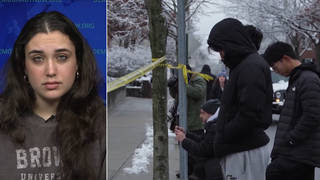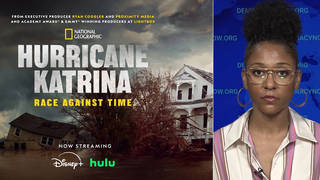
Topics
We speak with Robert Shimek of the Indigenous Environmental Network about the toxic pollution of the Mississippi River with various industries using it as a “sewer dump” to get rise of dioxins, PCBs and various heavy metals. [includes rush transcript]
- Robert Shimek, Special Projects Coordinator of the Indigenous Environmental Network.
Transcript
AMY GOODMAN: We’re talking about the devastating Hurricane Katrina that has hit very hard four states. And we’re focusing on New Orleans right now, but also looking at Mississippi and Alabama. We are joined by Damu Smith, who is the head of Black Voices for Peace. We’re also joined by Robert Shimek, Special Projects Coordinator of Indigenous Environmental Network; and David Helvarg, he’s author of the book Blue Frontier: Saving America’s Living Seas. David Helvarg, you talk about the big bowl, New Orleans, causing a witch’s brew. What do you mean?
DAVID HELVARG: Well, just the toxics, as was just being said. Between just Baton Rouge and New Orleans there’s some 36 petrochemical complexes, a lot of these pollutants. It’s historically been known as cancer alley. And as stated, a lot of poor people have been impacted. These waters, as well as all the household toxics and pollutants, as well as the cemeteries, a lot of which are above ground in New Orleans, will all be in the waters that are flooding this region. It’s in that sense a witch’s brew. It’s a very toxic environment that’s being generated, just as has happened when you had the flooding in North Carolina that went through the hog industry there. Here, it’s the petrochemical industry that puts people’s health at risk. And the risks are expanding exponentially. It’s not just poor people — [inaudible] bearing the brunt of the —- [inaudible] climate change all -—
AMY GOODMAN: You’re breaking up. David, you’re breaking up a bit. So if you could stay wherever you were. Because we were hearing you fine until just a second ago.
DAVID HELVARG: I was just saying that globally, the impacts of climate change are also being felt disproportionately by the poor people of the world, from island states like the Marshall Islands to Bangladesh to subtropical Africa, where agricultural impacts have the greatest impact. Last year we had a $42 billion hurricane season. This year’s on track to be perhaps even more devastating, certainly in terms of human life, potentially in terms of cost to the nation, financial costs. And it’s no longer; it’s not just that we’re in a 25-year cycle of intensified Atlantic hurricanes. It’s that we’re seeing — we’re in the footprint of climate change. Every scientist and climatologist I talk to say it’s clearly, if not in a 1988, then certainly 1997 and 1998, we saw more rain forest burn than at any time in history at the same time of global coral bleaching as a global event. We’re seeing these impacts and not responding to them, in terms of dealing with environmental refugees, dealing with the impacts on the poor, or dealing with the impacts on our increasingly populated coast, where we’re still promoting policies that drive people in harm’s way.
AMY GOODMAN: Robert Shimek, can you take us down the Mississippi? Talk about what’s in it and what it means to have this kind of hurricane at the base.
ROBERT SHIMEK: Thank you, Amy. And yes, I’m up here on the opposite end of the river, this is headwaters region of the Mississippi here in northern Minnesota. I cross the Mississippi several times on my way to work each day. And you know, over the years have just gotten intimately familiar with the character of the river here before it leaves, before it leaves this region. And I must say that, you know, what I’m hearing being described here on the air this morning is — you know, up here where we’re at, it’s, the river is of an entirely different character. You know, it’s a very soft and a very gentle and a very beautiful and inspiring river as before it leaves this state here.
Now, I also want to say that, you know, to the indigenous people of the region here, the headwaters is a very special place. It is a sacred place; it is a place that, you know, in our past, and even by some now, is regarded, you know, in a very special way, as in, you know, how we go there, how we approach it when we go to places like Lake Itasca, where the river’s origins begin.
And I would also say that, you know, aside from the mercury pollution, which we all have here in northern Minnesota, as well as other places throughout the country, that has affected the water quality in our lakes, aside from that, you know, the Mississippi is very clean here. As it comes through — there’s fish consumption advisories in pretty much all of the lakes here, statewide in Minnesota. But as the river leaves here, it, you know, of course we have those fish consumption advisories related to mercury. But we get our first consumption advisory related to dioxin at the community of Grand Rapids, which is probably, goodness, I’m going to say it’s less than the first hundred miles of the river from its headwaters. And that increasingly as it works its way toward the Gulf, you know, there’s this added burden of chemicals that cause it to, by the time it leaves Minnesota here, you know, many of the species of fish in the lower Mississippi, here in Minnesota, are not fit to eat.
And I encourage anybody, if you want to have a good history or a good chronology or a good documentation in terms of what happens to our river after it leaves here, you know, look at the Mississippi River fish consumption advisory. And of course, it’s increasingly worse as it works its way downstream. Now why is that? You know, clearly we have some of the same issues here in Minnesota with the industrialization of the river. You know, using it as a sewer dump for industry. And that, you know, many of the dioxins and PCBs and, you know, various heavy metals, you know, Minnesota is a contributor.
AMY GOODMAN: Robert Shimek, as you make your way down to Louisiana, talk about the changes and what you think this is going to mean with the level of water right now that is inundating Louisiana.
ROBERT SHIMEK: Well, I think that, you know, one of the things that we learned in the flood of 1993 was the role of wetlands along the river and its tributaries. There was, you know, some of you may remember, you know, in June of 1993, there was major flooding from the headwaters on down to, you know, about St. Louis, mid-river, lower river. And in the aftermath of that, the Corps of Engineers and others undertook a study to try and understand what happened, and from that study, realized that we had eliminated in excess of 80% of the wetlands along the banks of the Mississippi and her major tributaries and began to better understand the role of these wetlands in terms of filtering out agricultural runoff. You know, when we talk about the way the river is here and the huge dead zone off the Mississippi delta, or what’s left of the Mississippi delta, agriculture is, of course, a huge contributor. Agricultural runoff, as in feedlot runoff from cattle, pesticides and fertilizer, all draining into the river and contributing to the toxic load and, you know, the various other industries. I think that here in the northern reaches of the river, you know, it’s —
AMY GOODMAN: Let me bring David Helvarg in to talk about this dead zone.
DAVID HELVARG: Yeah. Well, as he was explaining, the agricultural runoff, the Mississippi drains 40% of America’s landmass, 50% of its agriculture. And because we’ve gone to petrochemical farming and industrial farming of corn in places like Iowa, you put 140 pounds of fertilizer per acre, all of that nutrient waste runs down the Mississippi and creates a second crop of algae in the Gulf of Mexico. Small critters and microbes feed on that and in the process of feeding on that, they take the dissolved oxygen out of the water. Everything that can’t breathe dies. And interestingly this summer with the warm water and the pollution, you had the largest dead zone to date, over 8,000 square miles. The hurricane may have brought oxygen back into the water but it’s not the way to fix the problem.
And one of the tragedies and hopefully one of the lessons is there are solutions, there are efforts we can do [inaudible] wetlands restoration. We can move away from industrial farming to organic and healthful modes that don’t create this nutrient load that impact our oceans. We can do planned retreat from coastal areas. There’s a government study says one out of four buildings within 500 feet of the oceans will be destroyed in the next 50 years. That’s a period when we should be doing planned retreat. We should be restoring the protective wetlands that are also the nurseries of the ocean and of the diversity of life we want to share on this planet. And as I say, the solutions are there.
There are these, you know, special interests. We know that necessity drives innovation. And we know now that we can’t continue to function and use the Gulf of Mexico and Louisiana as a place to generate fossil fuel that we burn that then intensifies the hurricanes that help undermine our coastal communities and way of life. And so, you know, we need new policies, and we need a new approach. We just put out a new book called the Ocean and Coastal Conservation Guide. We identify some 2,000 organizations just in the United States that are working to do what I call seaweed marine grassroots bottom-up. The solutions are there. We know how we can avoid — [inaudible] the consequences. We know that we can do things in a different way. But there are all of these special interests that have to be, have to be confronted in order to do the right thing.













Media Options